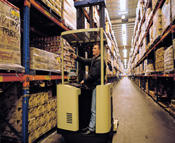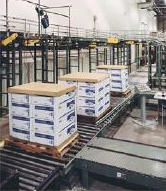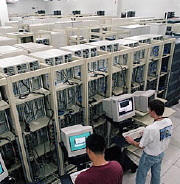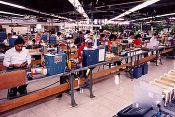Sept. 23, 2002 – During the Internet boom, companies selling applications that let customers and suppliers serve themselves on the Web promised huge returns on investment. Few of the customers that bought and installed those applications ever realized the dramatic savings promised. One reason: employees, customers and suppliers were reluctant to change the way they did things.
There is a dangerous perception among many that RFID is an almost magical technology. Many people believe that once tags and readers are installed, everything will happen automatically. Instead of scanning a bar code on a pallet, the forklift driver will simply drive through a portal and the RFID tag will be read automatically. Just put smart labels on individual products, and shelves will tell you automatically when stocks are running low. Unfortunately, it isn’t that simple.
The changes RFID will have on business processes are likely to be every bit as dramatic as the changes wrought by the Internet. We are addressing the issue early in this Special Report to emphasize just how critical the issue is. Most of the initial impact will be felt by frontline workers in warehouses and distribution centers and in the stockrooms of retail outlets. But eventually, RFID will change the way companies manufacture, market, and sell goods.
We can’t possibly address all aspects of the long-term changes in one article. The goal of this section of our Special Report Low-Cost RFID: The Way Forward is to highlight some of the cultural issues that are likely to come up as companies begin deploying RFID. Then, we’ll look at some of the medium-term effects on information technology, middle management and ultimately senior managers.
The goal of using RFID in a warehouse or distribution center is to increase efficiency and the accuracy of the data collected by taking people out of the loop. Ideally, an RFID system would be installed, all the old bar code scanners would be thrown away, and workers would just go about their business. The RFID tags would communicate automatically with readers, keeping track of everything that comes and goes. It may be possible to build such a system one day, but it won’t work like that initially.
The members of the Auto-ID Center that have been working on the field test and those who have deployed RFID technology from established vendors say no system is ever 100 percent accurate. That is, every tag isn’t read every time. Some redundancies can be built into the system to compensate for these shortcomings, such as adding additional antennas. But most companies will find it cheaper and more effective to have staff scan a tag manually when it is missed by, say, a portal reader.
The problem gets more complicated as you move from scanning pallets to cases and eventually individual units. As we said in Part 2 of this report, retailers will start by tracking cases and pallets. When pallets are broken down at a retail distribution center into smaller shipments to be sent to stores, workers will have to ensure that the tags on the manufacturers’ pallets coming into the DC have been properly read. Then, they will have to make sure each tag on each case has been read, and that the final pallet has been associated with the correct advance shipment notice. This may not seem like a lot of procedural change, but those who worked in warehouses a decade ago say it took three months or more to train staff to scan bar codes correctly, and people still make mistakes today.
A bigger headache is dealing with the problem of false reads. One day, there may be readers in all areas of warehouses and DCs that will provide real-time data on what’s actually in stock. But initially, to save money, companies will use RFID tags to identify racks and floor locations. Readers will be placed on forklifts. As the forklift puts the item on a rack or floor location, the reader will read the tag that says this is rack 123 and software will record that pallet 456 has been stored on that rack.
But there can be a lot of problems associated with this kind of an installation. Let’s say a worker wearing a large metal belt buckle walks through the field of a portal reader. The RF signal will be reflected in many directions and may pick up tags on product three bays away. And what if a forklift driver passes by a shelf tag four times as he adjusts the position of a pallet? Will the system record four pallets? And what happens when staff in a retailer’s stockroom begins moving product around while looking at things? Visibility is lost.
Software and readers may eventually be developed to compensate for some false reads. Some reader makers are considering having touch-screens so that a forklift operator can activate the reader when the item has been placed properly. But that reduces efficiency. Clearly staff are going to have to be trained to deal with some of these issues. Companies will need to establish rules for how product is handled and make sure they are followed.
This, however, can create its own problems. Staff may come to resent having to answer to machines that dictate where items should be placed. And if companies also put RFID tags in identification badges to ensure staff doesn’t walk out with a case of product, they may feel like Big Brother is always watching them. This could become a union issue.
When Technology Systems International sold its system for tracking prisoners using RFID (see RFID Reforms Prison Management), unions in Illinois and Michigan opposed the system for two reasons. One, correctional officers feared that they would be tracked when they went out for a cigarette break or were not where they were supposed to be. And two, the system would mean that fewer guards would be needed to supervise prisoners. The correctional department in Michigan struck a deal with the union in which it agreed not to use information from the system in employment disputes. These issues are likely to be common with RIFD.
And frontline workers aren’t the only ones that will feel threatened. As RFID systems take hold, operational changes and the anxiety they create will ripple up through the ranks.
IT departments will undergo two fundamental changes because of RFID systems, both of which will force them to become more involved in the operations of the business. The first change relates to the nature of IT systems. Up to now, the IT department’s main job has been to implement and maintain systems that provide managers with the information they need to make decisions. But RFID data will be real-time or near real-time. Managers won’t be able to react to all the information coming in. IT systems will change from providing information to incorporating some of the business managers’ intelligence and experience into the software so it can react automatically. That means IT folks will need to understand the business and why decisions are made.
The other change also has to do with the real-time nature of the data. Today, most IT systems work in batch mode. The manufacturing facility tracks how many pallets were shipped and then uploads the data in a batch file every day, every shift, or every few hours. As IT systems begin to take over some routine transactions and direct the movement of goods, reliability becomes crucial.
If a server goes down, the supply chain will be disrupted because computers won’t know where product is or where it should be sent. Companies will have to invest in fail-over capability, so redundant servers takeover automatically when there is a problem. This is no small change for IT departments used to spending 30 minutes to get a server rebooted. Says Bob Betts, SAP’s senior VP for global supply chain: “You have to change your whole IT management system. For some of the older-style IT people, this is going to be a real brain shift.”
Middle management is also going to undergo profound changes. Instead of managers controlling all aspects of operations, most transactions will be executed automatically by the system, and executives will largely manage by alerts and exceptions. For instance, the replenishment system that SAP is building with BiosGroup will automatically signal enterprise systems when there’s a potential out of stock. If the planning system can’t fulfill the need for product by going to alternate distribution centers or manufacturing facilities, and the system can’t resolve the issue with its fairly rudimentary logic, it would get bounced to a planner who could reprioritize the customers or shipments.
This change is likely to make many people very nervous. One reason is managers may fear that machines will eventually replace them. But even if they feel reassured that their job is safe, people are likely to resist any system that takes away their control and feeling of importance. One way to counter that is to keep all systems manual at first, even after items are being tagged with smart labels. Gather a history of transactions and of how problems were solved. After automating some of the routine transactions, begin adding rudimentary logic to deal with common exceptions.
For instance, if a manager sees a promotion has created a bigger than expected spike in daily sales and moves the next scheduled shipment up by one day, the system can be set up to respond the same way under the same conditions in the future. Gradually, more and more routine decisions can be automated, leaving managers to deal with more important tasks, like developing supplier relationships.
Perhaps the most important change within companies is going to be right at the top. Today, most CEOs and senior managers see their companies as unique and discrete entities. That is, they see their companies as football teams competing against other teams, not individual players on a team, working with others toward a shared goal. We think CEOs and top managers are going to have to learn to see their company as one member of a team, or part of complex economic ecosystem.
This will likely be the hardest change of all. For all the talk of collaboration over the past 10 years, very few companies have been doing it. A recent study by InformationWeek Research found that two-thirds of companies are in the early stages of deploying collaborative applications or haven’t even started yet. Many companies are still getting used to the idea that internal departments should share information and resources.
Collaboration is the key to achieving the real long-term benefits of an open, global RFID system. That’s because sharing data lets manufacturers and retailers reduce inventory while simultaneously reducing out of stocks. Wal-Mart has to share near-real-time data with suppliers like Procter & Gamble, so P&G can see a spike in demand created by a promotion and respond. And Wal-Mart can only reduce inventory if it can see that P&G has enough goods in the pipeline to meet demand.
The issue becomes more difficult and complicated when P&G tries to optimize its production facilities in conjunction with its suppliers. There will be pushback from suppliers that don’t want to incur the extra expense of tagging items or the risks of sharing data. Companies are going to have to manage these relationships and encourage their business partners to become part of the team. Eventually, they may even need to provide some IT infrastructure, in the form of agent technology, to their suppliers, so systems can be optimized across the supply chain.
As we said at the start of this installment of our Special Report, the changes RFID will bring will be as profound as those brought by the Internet. And we think that when it comes to managing that change, CEOs would do well to look at some of the companies that fully embraced the Internet. Cisco Systems and Dell computer didn’t just bolt Internet applications on to their existing operations. They made the Internet an integral part of every aspect of their operations.
Similarly, the companies that benefit most from RFID will be those that embrace change, that see RFID not as a way to save some money here or there, but as the means of becoming a real-time organization. Sure, those companies that sit back and analyze the ROI of each RFID application will get some benefits. But those benefits will pale in comparison to what’s achieved by those who really get it. Like Wal-Mart.





